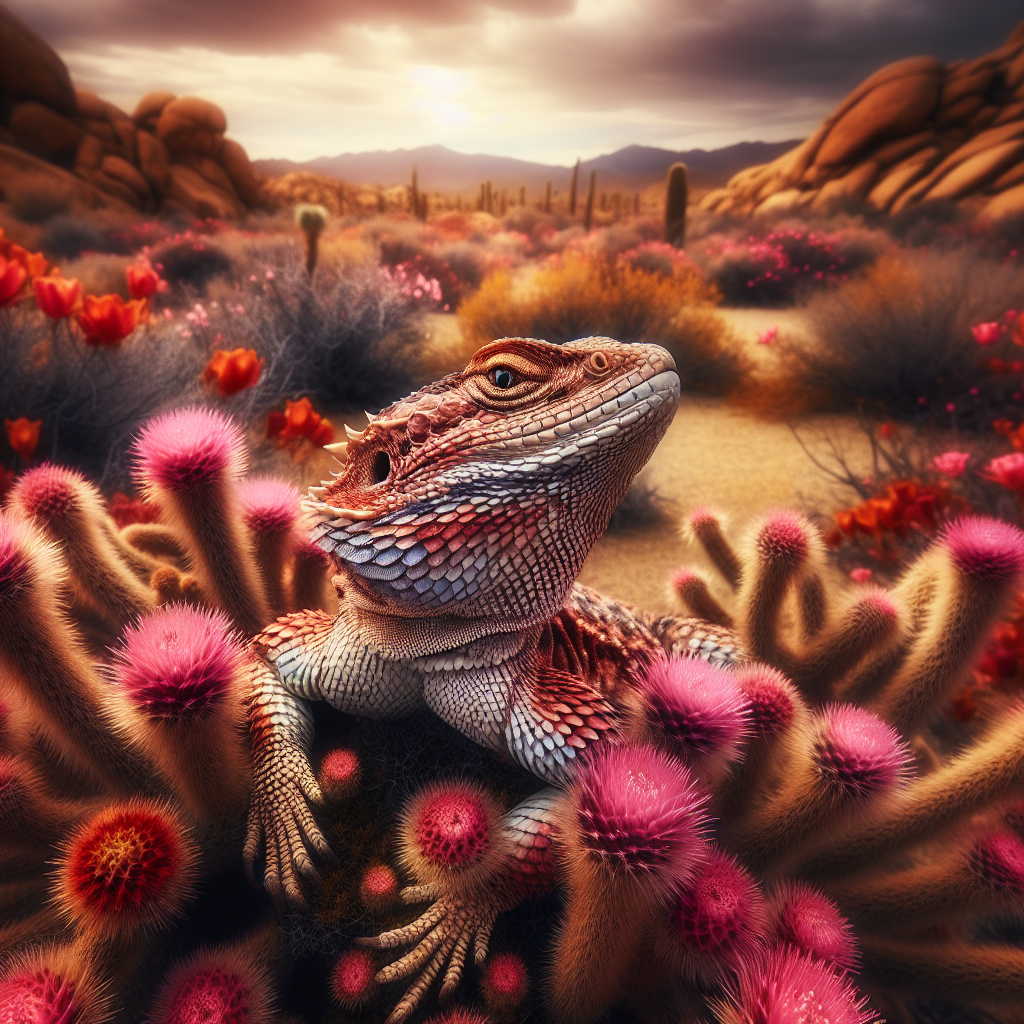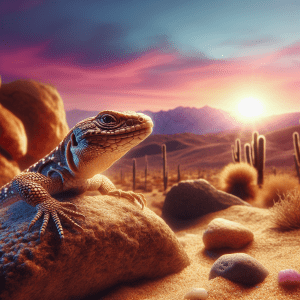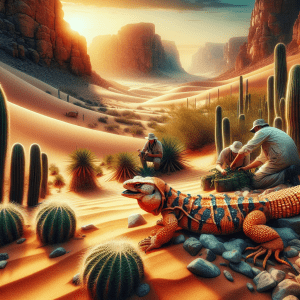Introduction to Mojave Desert Lizard Ecology
Have you ever marveled at the incredible diversity of lizard species in the Mojave Desert? These fascinating creatures are true survivors, perfectly adapted to thrive in one of the harshest environments on Earth. From the iconic Gila monster to the elusive horned lizard, each species has its own unique characteristics that make them stand out in the desert landscape.
One interesting fact about Mojave Desert lizards is their ability to regulate their body temperature by basking in the sun or seeking shade when needed. It’s a delicate balance that allows them to survive in extreme heat while conserving energy.
I’ve spent countless hours studying these remarkable creatures, observing their behavior and interactions with their environment. One thing that never ceases to amaze me is their resilience in the face of adversity. Despite the challenges they face, Mojave Desert lizards have found ingenious ways to adapt and thrive in their harsh desert home.
As you delve deeper into the world of Mojave Desert lizard ecology, you’ll discover a complex web of relationships that connect these creatures to their surroundings. Each species plays a vital role in maintaining the delicate balance of the ecosystem, highlighting the interconnectedness of all living things.
So, the next time you find yourself in the Mojave Desert, take a moment to appreciate the beauty and diversity of the lizards that call this arid landscape home. Their survival story is a testament to the incredible resilience of nature, reminding us of the importance of preserving these unique ecosystems for future generations to enjoy.
Importance of Lizards in the Mojave Desert Ecosystem
Imagine the Mojave Desert, a vast expanse of arid land, where lizards roam freely. Now, picture yourself observing these fascinating creatures in their natural habitat. The Mojave Desert is not just a barren wasteland; it is teeming with life, and lizards play a crucial role in its delicate ecosystem.
These resilient creatures have adapted to survive in the harsh desert environment, showcasing a remarkable diversity of species. From the iconic chuckwallas to the elusive horned lizards, each species has its own unique characteristics and behaviors that contribute to the balance of the ecosystem.
One interesting fact about Mojave Desert lizards is their ability to regulate their body temperature by basking in the sun or seeking shade, depending on the time of day. This behavior is essential for their survival in the extreme desert conditions.
As you delve deeper into the world of Mojave Desert lizard ecology, you’ll discover the intricate web of interactions that these creatures have with their environment. From hunting for prey to avoiding predators, every aspect of their behavior is finely tuned to ensure their survival.
Next time you find yourself in the Mojave Desert, take a moment to appreciate the beauty and resilience of these remarkable creatures. By understanding and respecting their role in the ecosystem, we can help ensure the conservation of Mojave Desert lizards for future generations to enjoy.
Species Diversity of Lizards in the Mojave Desert
Have you ever marveled at the incredible diversity of lizard species in the Mojave Desert? It’s truly a sight to behold. Imagine encountering a spiny lizard basking in the sun, its vibrant colors blending seamlessly with the desert landscape. These unique reptiles have evolved over time to thrive in the harsh desert environment, showcasing a range of fascinating adaptations. From the speedy zebra-tailed lizard to the cryptic desert iguana, each species has its own story to tell. Did you know that some Mojave Desert lizards have the ability to change color to regulate their body temperature? This remarkable trait helps them camouflage and avoid predators in their arid habitat. As you explore the Mojave Desert, keep an eye out for these remarkable creatures and observe their behavior in the wild. Understanding the species diversity of lizards in the Mojave Desert offers insights into the delicate balance of this unique ecosystem. So, next time you venture into the desert, take a moment to appreciate the beauty and complexity of these fascinating reptiles that call the Mojave home.
Adaptations of Mojave Desert Lizards
Have you ever marveled at the incredible adaptations of Mojave Desert lizards? These little creatures are truly remarkable. Their ability to thrive in the harsh desert environment is nothing short of amazing. Let me share some fascinating insights into the adaptations that make these lizards so unique.
One interesting fact about Mojave Desert lizards is their specialized skin that helps them regulate their body temperature. Their scales reflect sunlight, keeping them cool during scorching desert days. It’s like having built-in sunscreen and air conditioning!
Another remarkable adaptation is their ability to survive on minimal water. Mojave Desert lizards have evolved to extract moisture from their food and conserve water in their bodies. This is crucial for their survival in this arid environment where water sources are scarce.
Imagine observing a Mojave Desert lizard camouflaged against the sandy terrain, blending in seamlessly with its surroundings. Their coloration and patterns help them evade predators and hunt for prey effectively. It’s like a masterclass in stealth and survival strategies!
Understanding these adaptations gives us a deeper appreciation for the intricate balance of nature. The Mojave Desert lizards play a vital role in the ecosystem, contributing to the overall biodiversity and functioning of this unique habitat. Next time you spot a lizard basking in the desert sun, take a moment to admire the incredible adaptations that make it a true desert survivor.
Behavior and Reproduction Patterns of Mojave Desert Lizards
Have you ever wondered how Mojave Desert lizards manage to thrive in such a harsh environment? These amazing creatures have evolved some truly remarkable adaptations that allow them to survive and even thrive in the extreme conditions of the desert.
One fascinating fact about Mojave Desert lizards is their ability to regulate their body temperature by changing colors. Have you ever seen a lizard shift from light to dark to absorb or reflect sunlight? It’s like their own built-in temperature control system!
These reptiles also have specialized skin that helps them retain moisture in the arid desert. Imagine having skin that can prevent water loss in such a dry climate! It’s like having a natural hydration system built right in.
Another interesting adaptation is their unique locomotion skills. Mojave Desert lizards are known for their agility and speed, allowing them to quickly escape predators or catch prey. They have mastered the art of survival in this harsh environment through centuries of evolution.
So, next time you spot a Mojave Desert lizard scurrying across the sand, take a moment to appreciate the incredible adaptations that make them true desert survivors. It’s a testament to the wonders of nature and the resilience of these fascinating creatures.
Threats and Conservation Efforts for Mojave Desert Lizards
When it comes to research and studies on Mojave Desert lizard ecology, there’s a whole world of fascinating discoveries waiting to be unearthed. Scientists and researchers have delved deep into the intricate web of interactions that these remarkable creatures have within their environment.
One interesting fact that often surprises people is the level of intelligence displayed by Mojave Desert lizards. These creatures have evolved sophisticated behaviors and survival strategies over time, making them truly remarkable subjects for study.
Research on Mojave Desert lizard ecology not only sheds light on the lives of these reptiles but also provides valuable insights into the overall health of the desert ecosystem. By understanding how lizards adapt to their environment and respond to changes, scientists can gauge the impact of human activities on the delicate balance of the Mojave Desert ecosystem.
As you delve into the world of Mojave Desert lizard ecology, you might find yourself pondering the broader implications of this research. How can our understanding of lizard behavior inform conservation efforts in the region? What can we learn from these resilient creatures about adapting to harsh environments?
So, the next time you spot a lizard darting across the desert sands, take a moment to appreciate the intricate web of life that surrounds these fascinating reptiles. There’s always more to discover in the world of Mojave Desert lizard ecology.
Research and Studies on Mojave Desert Lizard Ecology
Have you ever wondered what goes on in the world of Mojave Desert lizards after dark? Well, let me tell you, it’s a whole different ball game! These fascinating creatures are masters of the night, engaging in activities that would make even the most dedicated night owl jealous.
Picture this: the sun has set, and the Mojave Desert is cloaked in darkness. While we humans are winding down for the day, Mojave Desert lizards are just getting started. Under the cover of night, they emerge from their daytime hiding spots to hunt for food, socialize, and engage in their unique behaviors.
One interesting fact about the nocturnal activities of Mojave Desert lizards is their exceptional hunting skills in low-light conditions. These creatures have adapted to navigate and locate prey using their keen senses of smell, sight, and hearing, making them formidable predators in the dark.
As we delve deeper into the mysterious world of Mojave Desert lizard ecology, we uncover the hidden intricacies of their nighttime rituals. From intricate mating displays to stealthy hunting techniques, these creatures have evolved to thrive in the challenging desert environment, even under the cover of darkness.
So, next time you find yourself in the Mojave Desert after sundown, take a moment to appreciate the nocturnal wonders that unfold around you. Who knows, you might just catch a glimpse of these elusive lizards in action, showcasing their remarkable adaptations and behaviors under the starlit sky.
Human Interactions with Mojave Desert Lizards
Have you ever wondered how human interactions affect the lives of Mojave Desert lizards? It’s a topic that’s close to my heart because understanding our impact on these fascinating creatures is crucial for their survival. Let me share an interesting fact with you – did you know that urban development and recreational activities often disrupt lizard habitats, leading to population declines? It’s a sobering reality that we need to address.
When we build roads, homes, and recreational facilities in the Mojave Desert, we encroach on the natural habitats of lizards, disrupting their ecosystems. This can result in habitat loss, fragmentation, and increased exposure to predators. Imagine being a lizard trying to navigate a world that’s rapidly changing due to human activities – it’s a tough situation to be in!
So, what can we do to minimize our impact on Mojave Desert lizards? One practical tip is to stay on designated trails when exploring their habitat. By sticking to established pathways, we can help reduce habitat disturbance and protect the fragile ecosystems that support these unique creatures. It’s a small action that can make a big difference in preserving the delicate balance of nature.
As we delve deeper into the complexities of human-lizard interactions, let’s reflect on the importance of coexisting harmoniously with the wildlife that shares our planet. Our choices today will shape the future of Mojave Desert lizards and their habitats. Let’s strive to be mindful stewards of the environment, ensuring a sustainable future for all species that call the desert home.
Tips for Observing Lizards in the Mojave Desert
Have you ever wondered how to observe Mojave Desert lizards in their natural habitat? Well, let me share some expert tips with you.
When you venture into the Mojave Desert, keep your eyes peeled for movement among the rocks and bushes. Lizards are masters of camouflage, blending seamlessly into their surroundings.
To increase your chances of spotting these elusive creatures, try visiting during the early morning or late afternoon when they are most active. The desert sun can be scorching, so be sure to stay hydrated and wear appropriate sun protection.
If you’re lucky enough to catch a glimpse of a lizard, approach slowly and quietly to avoid startling them. Remember, these reptiles are essential to the desert ecosystem, playing a crucial role in controlling insect populations and serving as prey for larger animals.
By observing Mojave Desert lizards in their natural habitat, you can gain a deeper appreciation for the intricate web of life that exists in this harsh environment. So, take your time, be patient, and enjoy the thrill of discovering these fascinating creatures in their desert home. Who knows what secrets they might reveal to you?
Conclusion: Appreciating the Ecological Role of Mojave Desert Lizards
Have you ever stopped to marvel at the incredible world of Mojave Desert lizard ecology? These fascinating creatures play a crucial role in the delicate balance of this arid environment. Just picture a sun-kissed lizard darting across the sandy terrain, blending in effortlessly with its surroundings. It’s like watching a master of camouflage in action! Mojave Desert lizards have evolved some truly remarkable adaptations to survive in this harsh landscape. From their ability to regulate body temperature in extreme heat to their unique ways of finding food and avoiding predators, these creatures are true survivors. But did you know that despite their rugged resilience, Mojave Desert lizards face numerous threats to their existence? Human development, climate change, and habitat destruction all pose significant challenges to these remarkable reptiles. As an expert in Mojave Desert lizard ecology, I am constantly amazed by the intricate web of life that exists in this seemingly barren landscape. It’s a reminder of the interconnectedness of all living things and the importance of preserving our natural world. So the next time you spot a lizard scurrying across the desert floor, take a moment to appreciate the beauty and complexity of Mojave Desert lizard ecology.




